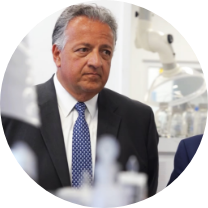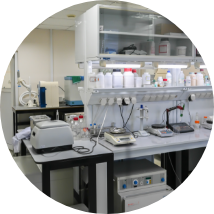

Galien week of innovation
THURSDAY NOV. 07
ALEXANDRIA CENTER FOR LIFE SCIENCE, NEW YORK CITY
The 2024 edition presented a rich program of critical and emerging topics at the heart of the life science research, regulation and access. Watch the exciting discussion and debates below.
2024 Program

GALIEN FORUM CO-ChairS
Michael Rosenblatt
Galien Forum Co-Chair; Prix Galien Committee Chair (Categories: Pharma, Biotech, Rare/Orphan); Advisory Partner, Ascenta Capital; Senior Advisor to Bain Capital Life Sciences and Flagship Pioneering
Phillip A. Sharp
Nobel Laureate; Galien Forum Co-Chair; Institute Professor and Professor of Biology Emeritus, Koch Institute for Integrative Cancer Research, MIT
Chair
Julie Louise Gerberding
President and Chief Executive Officer, Foundation for the National Institutes of Health
PANELISTS
Director, Eunice Kennedy Shriver, National Institute of Child Health and Human Development, NIH
President and Chief Executive Officer, Vital Strategies
Former Chief Scientific Officer, Ferring US; Immediate Past President, American Medical Women’s Association
Sandra Milligan
President, Aspira Women's Health, Organon
Sans Thakur
Founder and Chairwoman of TOWER Capital Group and the pioneer of Generational Health
Background and Topics for Discussion:
Decades of institutional neglect and cultural indifference have left a glaring gap in the breadth of knowledge and data on the health of women as compared to men. Improving women’s health is, at its core, an issue of health equity and inclusivity, and would raise the quality of life for women. Such advances would also benefit the global economy and the health of future generations. The McKinsey Health Institute recently published a comprehensive analysis of the impact that a greater investment in women’s health would have on the global economy, along with addressing a significant societal moral benefit. Specifically, an investment to improve women’s health would provide a $1 trillion benefit to the global economy by 2040.
Evidence suggests the value contributions added by women at home, at work, and in the neighborhood increases when their disease burden decreases. A lower incidence of the many health challenges facing women before, during, and beyond their reproductive years could have multiple beneficial effects, including raising economic growth and social resiliency.
As the science behind regenerative medicine improves, gender-specific innovations allow more women to live longer, healthier lives and promise to leave a better genetic footprint for future generations. Such contributions are only now being acknowledged, prioritizing women’s health around a holistic, cross-disciplinary construct called “generational health.” The aim is to emphasize identifying and treating the gender-specific needs of women throughout their life span, beyond their reproductive years.
Prioritizing women’s health remains a work in progress. The good news is many initiatives are being launched to redress the imbalance in women’s health, not only in the levels of public research funding but also in developing new technologies and tools, such as large datasets to allow evaluation of sex and gender differences to treatment response for various diseases. Yet other institutional barriers remain, such as the biopharma industry’s struggle to find a sustainable, long-term commercial business model centered on women’s health. Addressing ingrained, gender-driven resource inequities and recognizing the impact that a greater investment in women’s health would have on the global economy and society is a step forward.
Topics the panel will address include:
- Investment gaps in women’s health: What is the relationship between the prioritization of the social drivers of women’s health and what health systems actually invest in? What is being done to address the scarcity of data on women’s health that perpetuates gender bias and prolongs the underfunding of gender-specific research? Where are we still falling short?
- Addressing “full spectrum” of women’s health needs: Women’s health traditionally has focused on reproductive health. Has this emphasis led to a neglect of the full spectrum of women’s health needs? Can better health outcomes for women worldwide be secured without an accompanying transformation of the “gender gap” between men and women? Is changing the cultural and socio-economic status of women a public health challenge?
- Reset of business model to solely focus on women’s health: Are life sciences companies and venture capital funders more –or less– engaged in women’s health now that a reset of the biopharma business model is underway after the pandemic? Is it possible to build a profitable, stand-alone business focused on women’s health?
Opening Remarks & Chair
Rohit Aggarwala
Chief Climate Officer, City of New York
PANELISTS
Deputy Assistant Secretary for Climate Change and Health Equity and Director, Office of Climate Change and Health Equity, U.S. Department of Health and Human Services
Chair of the Galien Africa; Former Senior Minister to the President of the Republic of Senegal; Former Minister of Health, Republic of Senegal
Executive Leader in Life Sciences Innovation and Global Health; Chair of the Scientific Advisory Board, INTREPID Alliance
Co-Chair, Lancet Commission on Sustainable Healthcare, Yale
Climate change is disrupting the contours of human health in ways that are only now being assessed and quantified. The markers of mortality and morbidity are legion, from heat-related illnesses that contribute to edema and cardiovascular failure; respiratory ailments like asthma and allergies from airborne pollutants; fatalities, injuries, mental illness and habitat loss from severe weather events; changes in vector ecology that spread malaria, dengue fever and a host of other pathogens while enhancing prospects for zoonotic disease transmission; water quality impacts, led by cholera; and increased malnutrition induced by climate pressures on the natural environment, farming and the food supply.
In May, the World Health Assembly (WHO) reiterated its position on climate change as humanity’s single biggest health threat, forecasting 250,000 additional deaths per year worldwide between 2030 and 2050. The WHO estimates that direct damages to health system infrastructure from extreme weather events alone will total $4bn annually by 2030, a trend destinated to waylay the organization’s plans to introduce a basic global platform of universal health coverage, including access to affordable essential medicines for all, the same year.
Vulnerable populations like the poor, children and the elderly will be disproportionately affected. Beyond the documented income losses, climate change undermines many of the basic social determinants of health, such as equality and access to care as well as the local community support structures that act as a hedge against economic displacement and mass migration.
Pressure is mounting on business and the private-sector to do more to address climate change. The Intergovernmental Panel on Climate Change (IPCC) has resolved that, to avert a truly catastrophic trajectory to unsustainable weather patterns, action must be taken now to limit carbon emissions and prevent further rises in global temperature by no more than 1.5 C by 2050. Accomplishing this goal depends heavily on the private-sector to help finance a global “green transition” tied to major new investments in renewable, zero-carbon energy technologies that don’t rely on fossil fuels. The IPCC now estimates $2.4 trillion a year in combined global and country financing/investment commitments will be needed well into the next decade to jump start the transition.
There is also an expectation that at least a part of this investment be earmarked for countries of the global south, with the preferred vehicle being public-private partnerships involving key multilateral lenders like the World Bank. The idea is to leverage such partnering as a way to “de-risk” the exposure for companies investing in geographies where business confidence is low.
The health impacts of climate change pose particular challenges for the pharma and biotech sector. The extensive global supply chains that big pharma companies rely on in the manufacture and distribution of medicines have led to scrutiny by climate change advocates, who are demanding a higher level of “resource stewardship” from management. There is also pressure on the shareholder front to ramp up environmental disclosures and compliance under voluntary company ESG commitments.
More important, government regulators like the US Securities and Exchange Commission (SEC) and the European Commission are moving forward with plans for even more transparency on industry actions to address climate change. The SEC rule mandates public companies to report annually on carbon emissions levels, exposure to risks from global warming and the status of strategies to address it. The EU rule is more prescriptive and calls for evidence on how the company business model and commercial strategies are compatible with the climate reduction provisions of the 2015 Paris Agreement of the UN Framework Convention on Climate Change, including impacts on atmospheric pollution; water and marine resources; and land-based biodiversity and ecosystems – at every step of the company value chain.
Overall, climate change makes for more uncertainty for big pharma in operating an essential complex business with numerous customer touchpoints, at scale and across diverse geographies. Extreme weather conditions alone promise supply bottlenecks and product shortages from the loss of manufacturing capacity around temperature-sensitive products with limited shelf life. Long term, the industry will have to confront external demands for changes in its R&D portfolio, in some cases for conditions accentuated by climate change that carry a lower profitability ratio than other disease areas. Finally, coping with these climate-related risks will require significant new investments in due diligence and hazard avoidance capabilities, extending deep into the third-party supply and support networks where compliance has always been hard to establish.
Topics for Discussion:
- Current state of academic and institutional research on the relationships between climate change and human health – what does the evidence show? Real world implications for health status, public health provision and disease spread if countries fail to meet UN Paris Convention commitments to limit growth in fossil fuel emissions by 2050.
- Scientific researchers have found a way for plant seeds to effectively fertilize themselves, a discovery with the potential to reduce reliance on fossil fuel-based fertilizers in agriculture. Are there similar impactful innovations underway to address the harmful effects of climate change on disease and other key public health parameters?
- In the US, just under 10% of our national carbon footprint can be attributed to business practices of the health care industry. Is the industry moving at an appropriate pace to lower its carbon profile? What additional actions can the pharmaceutical and biotech sector take to address the challenge? Do the standardized company reporting guidelines that allow the public to assess and compare progress on climate change act as an incentive or as a burden, in terms of doing more?
- Is the international negotiating framework now in place for addressing climate change sufficiently enabled to tackle the public health aspects of the threat? Are government negotiators sufficiently aware of the private-sector’s commitment and contributions to meeting climate-related targets?
- Africa is a relatively poor continent which contributes marginally to global warming but whose livelihoods are disproportionally damaged by its effects. What can the region’s experience tell us about what works and what doesn’t in addressing what is now an existential global challenge? Is progress simply an issue of extracting more concessional aid through a revamp of the current international financing system? What can we learn from local approaches built around community awareness and empowerment? Can the continent achieve a better balance between exploiting abundant extractive industry resources and transitioning to greener, renewable technologies?

Chair
Ezekiel J. Emanuel
Vice Provost for Global Initiatives; Co-Director, Healthcare Transformation Institute; Diane v.S. Levy and Robert M. Levy University Professor; Perelman School of Medicine and The Wharton School; University of Pennsylvania
PANELISTS
Co-founder and Chief Executive Officer, H1
Chief Executive Officer, Morgan Health, JPMorgan Chase & Co.
John M. O'Brien
President and Chief Executive Officer, National Pharmaceutical Council
Janet Woodcock
Former Principal Deputy Commissioner, U.S. Food & Drug Administration
Background and Topics for Discussion:
Health care in the US continues to adapt to the structural weaknesses exposed by the Covid-19 pandemic. Industry has responded with initiatives to consolidate market positions and test out new business models, all with the aim of mastering a moving chessboard of competitive challenges. These include reducing cost exposures, realigning business operations to achieve the long-awaited “digital transformation” and fending off inroads from adjacent players seeking a foothold in an opportunity-rich sector that now accounts for almost one-fifth of US GDP.
Also demanding industry attention is the pandemic’s effect on government involvement in health care. The Biden Administration has positioned access to health as a right, not a privilege, advancing an expansive post-Covid legislative agenda focused on lowering prescription drug costs and insurance premiums; enhancing coverage under the subsidized insurance marketplace option provided through the 2010 Affordable Care Act; more federal funding for the low-income federal-state Medicaid program; and an aggressive legal stance on anti-competitive behaviors. Still in play is a bipartisan congressional effort to impose more transparency on the business practices of the pharmacy benefit manager (PBM) segment that most private-sector employers rely on to manage drug benefit costs – and where three giant PBM companies now control 80% of the US market.
Big pharma companies are uniquely exposed to provisions enacted in the 2022 Inflation Reduction Act (IRA) which, for the first time, grants the federal government’s Medicare program for seniors authority to negotiate with individual drugmakers the price of the most profitable and widely used branded medicines prescribed to patients. This, in addition to a steep upward revision of drug manufacturers’ percentage-based cost-sharing contributions to reimbursement under Medicare, means that companies face a much more difficult (and ultimately less profitable) set of calculations in deciding whether to participate in a program that currently accounts for slightly more than half of overall prescription drug sales in the US. The concern is that the growing weight of government on the industry will “bleed” to the employer-driven commercial payer side.
Taken together, such changes carry the potential to shift US health care markets, policy and regulation in new, unanticipated directions. The big question for this moment is whether the industry playbook has changed as well.
Panelists will discuss these and other issues, including:
- Defining the new US healthcare and medicines innovation landscape in the aftermath of Covid-19. What has changed in the calculations required to deliver revenue growth and profitability to industry shareholders and meet the expectations of policy-makers and the public at large?
- Ways in which a soaring post-Covid public debt load and mounting federal spending deficits will shape the US health reform debate. What measures are needed to preserve current standards of patient care and fund new drug research and other drivers of medical innovation, where the US leads the world? Will the piercing of the $1 million per drug barrier for gene therapies lead to a more expansive interpretation of accessibility, one based on the lifetime value of a cure?
- How will the Biden Administration’s expanded government role in health care financing and delivery play out? Are the impacts of the sweeping 2022 IRA legislation on negotiated Medicare drug pricing sufficiently understood by industry and the public?
- Viewed from another perspective, can the FDA maintain its independence as industry regulator in a drastically more politicized decision-making environment in Washington?
- Most working Americans receive health care benefits through private-sector commercial insurance plans. What innovations are taking place in this sector to tackle rising employer cost contributions while maintaining the competitive benefits that workers expect? Is the PBM controlled network pharmacy and formulary model down for the count?
- There is an emerging bipartisan consensus to force more transparency on drug pricing and other, often opaque, commercial business practices within the industry overall. What impact will this year’s election have in charting the way forward – and what does it mean for the future of new drug development? Is the US longtime status as preferred first country of launch in jeopardy?
- Geopolitical risk has emerged as a top issue for the biopharma C-suite – unanticipated disruptions in the global pharma supply chain is just one threat now on the table. What role should regulators and drug companies play in reversing the sharp rise in drug shortages (which reached a record high in the last quarter of 2023) that harm vulnerable patients? What’s the next step toward joint risk management and regulatory harmonization across the entire supply chain, involving all the key country sources of medicines worldwide?
- Hazard a guess: will the US health system look more like those of western Europe in 2030? Will investing decisions on US drug innovation remain in private-sector hands or in a more dispersed “social partnership” model?
COFFEE BREAK
10:05 AM - 10:15 AM
Chair

Co-Moderators
Joel S. Marcus
Executive Chairman & Founder, Alexandria Real Estate Equities, Inc./Alexandria Venture Investments; Co-Founder, Alexandria Summit
Lynne Zydowsky
Chief of Science, Alexandria Real Estate Equities, Inc./Alexandria Venture Investments; President & Co-Founder, Alexandria Summit
PANELISTS
Steve Harr
President and Chief Executive Officer, Sana Biotechnology
Thomas J. Lynch Jr.
President and Director, Raisbeck Endowed Chair, Fred Hutchinson Cancer Center
Priya Singhal
Executive Vice President, Head of Development, Biogen
Panel Background:
This pivotal discussion brings together leading experts to explore the transformative potential of immunology in modern medicine.
Immunology and inflammation have emerged as fundamental pillars in how we approach a wide array of human diseases, from cancer to autoimmune disorders. Recent breakthroughs in our understanding of the immune system are leading to revolutionary therapies and opening new frontiers in medical science. Our distinguished panel will delve into the latest advances, current challenges, and future opportunities for harnessing the immune system to combat chronic and inflammatory disorders.
Our panelists will survey cutting-edge research, innovative therapies, and the potential of immunology to revolutionize patient care. They will also discuss how immunological and anti-inflammatory approaches are reshaping our understanding of disease mechanisms and opening new avenues for treatment. These latest developments — from engineered cell therapies to novel immunomodulatory drugs — promise to transform the treatment landscape for millions of patients worldwide.
As we navigate the complexities and promise of immunology, we invite you to engage in this thought-provoking discussion on one of the most promising fields in medical science today.
Topics for Discussion:
- Discuss the current state of scientific understanding surrounding the human immune system and the areas of research that hold the greatest promise over the coming decade to address unmet need in autoimmune disorders, cancer, and other chronic and inflammatory diseases. How close are we to a time where precision medicine approaches (e.g., individual profiling of immune systems) will be widely accessible for informing patient care?
- What therapeutic modalities have emerged, or are on the horizon, that could revolutionize how we target or leverage the human immune system to combat inflammation and disease? Are we closer to achieving true cures for any autoimmune or inflammatory diseases in our lifetime?Highlight the current state of immuno-oncology (IO) research and the broader IO drug development landscape, and examine the impact of immunotherapy on patient care. Has the revolutionary promise of IO lived up to its expectations over the past decade, or has it overpromised and underdelivered? How are AI, big data, and novel computational methods impacting our understanding of the human immune system? Is AI having a broad and meaningful impact on drug development yet, or are we still years (or even decades) away from realizing the real potential of AI on the development of new therapies? Beyond oncology and autoimmunity, how is our evolving understanding of the human immune system shaping therapeutic approaches to other indication areas, such as neuroscience and metabolism? Is the immune system truly the cornerstone of nearly all disease pathology?
- With the cost of and accessibility barriers to novel immunotherapies, will costs to manufacture and scale many next-gen modalities pose a critical challenge to patient access? What measures can regulators take to accelerate the development and approval of new immunotherapies and ensure patient access and affordability?

MODERATOR
Michael Rosenblatt
Galien Forum Co-Chair; Prix Galien Committee Chair (Categories: Pharma, Biotech, Rare/Orphan)Advisory Partner, Ascenta Capital; Senior Advisor to Bain Capital Life Sciences and Flagship Pioneering
PANELIST
Noubar Afeyan
Founder and Chief Executive Officer, Flagship Pioneering and Co-founder & Chairman, Moderna

PRIX GALIEN AWARDS CEREMONY

11:45 PM - 12:30 PM
Tribute to Bernard Poussot followed by awards ceremony for the categories: Best Medical Technology, Best Digital Health Solution, Best Incubator/Accelerator/Equity and Best StartUp
MASTER OF CEREMONY
Kenneth C. Frazier
Prix Galien Committee Chair (Categories: Medtech, Digital Health, IAE and Startup); Retired Chairman and Chief Executive Officer, Merck & Co., Inc.; Chairman, Health Assurance Initiatives, General Catalyst
LUNCH BREAK
12:30 PM - 1:00 PM
Chair
Chair
Phillip A. Sharp
Nobel Laureate; Galien Forum Co-Chair; Institute Professor and Professor of Biology Emeritus, Koch Institute for Integrative Cancer Research, MIT; Co-Chair of the Galien Forum
PANELISTS
Senior Vice President Global Research Emeritus, Amgen
Chief Medical Officer and Executive Vice President, Development & Medical Affairs, Alnylam
Executive Vice President and Head of Research, Biogen
Board Co-Chair, President and Chief Scientific Officer, Regeneron
However, what has worked well to date is no guarantee against the uncertainties exposed by a pandemic that no one predicted, eroded what used to be the consensus on the positive role of science in society, and revealed major shortcomings in public health and institutions that support innovation. Responses in the form of a tougher pricing environment will force a significant realignment of priorities toward reimbursements where payers have the momentum. The most innovative gene-based therapies will need to work harder to earn a predicable rate of return, balancing the promise of a cure against the enormous up-front overhead risks assumed by the originator company in safely delivering the therapy to what is often a very small cohort of patients. Building in the technology to make these cost manageable is crucial to the future of patients benefiting from gene-based interventions. A focus on raising operational efficiencies include risk-based capital allocation, financial resilience, talent retention as well as the distractions of replacing legacy data systems with a radical, more strategic approach to information management. An agenda like this sounds much like the path forced over the past few years on an over-bureaucratized “big Pharma:” it raises the question, can the two players – big bio and big pharma – be that far apart?
Panelists will address these and other issues, including:
- Evolution of the biotech business model since the founding of Genentech in 1976 to commercialize the nascent promise of recombinant DNA technology. Fifty years on, is drug biotech still an emerging industry in search of a sustainable revenue base? Is size, scale and reach the only feasible path to success in today’s era of expensive new science and growing payer consolidation?
- Looking ahead to the end of this decade, what areas of biologic science applied to drug discovery offer the greatest potential in outcomes that are meaningful to patients and payers?
- Can we expect AI-leveraged computation and large-scale data sets to serve as the cure-all to persistently high attrition rates in drug development? Or is it just one element in a larger scenario of progress?
- Is VC and other investor funding streams aligned to the unpredictable payout cycles likely to occur in a fast-evolving therapeutic space? Is the government/regulatory community ready with the expertise, resources and policy commitments to incentivize private-sector risk in taking ground-breaking technologies to timely market approval, and beyond?
- Managing the operational challenges of making breakthroughs in science more cost-effective, particularly in key areas like biologic drug manufacture and how novel platform therapies like Crispr can be delivered to patients in vivo. How soon will we move gene-editing and CAR-T cell therapy “over the finish line,” as the reliable standard of care for heritable diseases as well as for more common conditions?
- Message to the next US Administration: what “big biotech” needs to keep succeeding for patients.
Chair
Alan Moses
Independent Pharmaceutical/Biotechnology Consultant; Former Global CMO, Novo Nordisk A/S; Board of Directors, Joslin Diabetes Center
PANELISTS
Stephen L. Gough
Global Chief Medical Officer and Senior Vice-President of Global Medical Affairs, Novo Nordisk
Mark Hartman
Vice President of Medical, Lilly Research Laboratories, Eli Lilly and Company
Anthony Hollenberg
President of Boston Medical Center and Professor of Medicine, Boston University Chobanian and Avedisian School Medicine
Jeff McIntyre
Vice President, Liver Health Programs, Global Liver Institute (GLI)
Ira Tabas
Richard J. Stock Professor and Vice-Chair of Research, Department of Medicine, Columbia University Irving Medical Center
Søren Tullin
Senior Vice President and Global Head of CardioMetabolic Diseases Research, Boehringer Ingelheim
Background and Topics for Discussion:
Research to understand the complex biologic and lifestyle factors that contribute to chronic disease is opening new doors for medicines linked to the human condition known as metabolic syndrome. The syndrome underlies or contributes to numerous debilitating diseases which often appear in patients simultaneously, making research, diagnosis and treatment more challenging.
A prominent example of clinical progress in this area is a new generation of incretin hormones (GLP-1 receptor agonists, dual (GLP-1 and GIP) agonists, and other combinations) medicines originally developed to improve glucose control in diabetes that now show much broader efficacy as pharmacologic approaches to overweight and obesity. The fact that obesity is a foundational condition associated with diverse health risks beyond diabetes (as many as 200, according to some estimates) means these new drug classes – and potentially others on the horizon – will add to our therapeutic armamentarium against metabolic syndrome. Even modest research breakthroughs in this area not only will contribute to improved health for individual patients but have the potential to contribute to improvements in population-wide health outcomes as well as easing the burden metabolic diseases place on scarce health resources.
Today’s panel focuses on a proliferating but still “under the radar” liver disorder, Metabolic Dysfunction-Associated Steatohepatitis (MASH). It’s a new name (replaceing the term NASH) for an existing condition that is both deadly and largely asymptomatic. Patients with MASH experience a progressive metabolically driven build-up of excess fat in the liver, resulting in inflammation and cell death that progresses to fibrosis and scarring that can lead to cirrhosis. Advanced cirrhosis may eventually necessitate a transplant as the only option remaining to prevent death. Today, an estimated 22 million US adults are living with MASH and its related stages and co-morbidities. A large proportion of victims have yet to be formally diagnosed or are not receiving treatment. Awareness of MASH as a mortality risk and public health threat remains low, an unfortunate situation because the disease can often be prevented entirely through lifestyle changes and behaviors before the need for pharmacologic intervention.
With such statistics in mind, clinicians are working to clarify the nomenclature for diagnosing and managing this disease. In 2023, a joint collaboration between hepatology clinicians and patient groups proposed that the disease’s existing name, Non-Alcoholic Steatohepatitis (NASH) be dropped, on grounds that the “non-alcoholic” label failed to accurately define the disease as the “hepatic manifestation of metabolic syndrome.” MASH (and its accompanying label for less severe forms of the disease, Metabolic Dysfunction-Associated Steatotic Liver Disease (MASLD) also removes the “stigmatization” linked to the previous label’s indirect reference to excess consumption of alcohol. Likewise, the existing shorthand characterizing a milder version of this disease, Non-Alcoholic “Fatty Liver” Disease (NAFLD) was abandoned for seemingly targeting obese patients to the exclusion of others who might benefit from treatment.
The new designations mark a turning point in securing greater awareness among patients, clinicians and the public about the many dangers of MASH and the burden it imposes on the health system. MASH is the leading cause of the steep rise in costly liver transplants in the US: more than 10,000 were performed in 2023 alone. More important, seemingly unrelated co-morbidities from MASH ranging from heart disease, type 2 diabetes, solid tumor cancers and even neurocognitive decline also can result in death. In fact, patients with MASH/MASLD are twice as likely to die of cardiovascular diseases (CVD) than from liver failure.
In recent years, the complexity of MASH as a research target and the challenges of clinical development programs persuaded a number of leading drugmakers to abandon development programs in this disease area, with numerous candidates failing in early development. This situation now is changing as the insights around metabolic signaling derived from the GLP-1 agonist class bear fruit.
In March, the FDA granted the small biotech Madrigal Pharmaceuticals conditional approval to Rezdiffra (resmetirom), a thyroid hormone beta receptor agonist for adults with noncirrhotic non-alcoholic steatohepatitis characterized by moderate to advanced liver scarring (fibrosis). The first treatment that directly addresses the liver damage that can lead to liver failure and death, Rezdiffra bears a requirement for use only in conjunction with a lifestyle regimen of diet and exercise; clinical benefit must also be reaffirmed on completion of another 54-month clinical trial. Multiple other biotechnology and biopharmaceutical companies including three represented on this panel (Boehringer-Ingelheim, Eli Lilly & Co. and Novo-Nordisk A/S) have MASH candidates in development , all of which build on the potential of their vastly successful GLP-1 weight loss molecules.
Topics our six-member expert panel may address include:
- Identify and assess the most promising biologic pathways toward treating and curing MASH/MASLD. Is big pharma and biotech on course to “crack the code” on metabolic syndrome?
- Define the principal barriers to the approval of novel drug therapies for MASH/MASLD from a discovery, development, regulatory and patient access perspective. Do the potential financial returns justify the investments in R&D?
- Identify the challenges in providing better diagnostics to screen, identify and track MASH/MASLD. Are current clinical practice guidelines adequate to the task of differentiating among the many facets of this condition?
- What strategies are necessary to build awareness of MASH/MASLD and assure patient behavior changes are introduced early enough to prevent liver failure as the ultimate end point of disease? Is losing weight the single best response to reversing the course of disease?
Co-Chairs
Petra Jantzer
Senior Managing Director, Global Life Sciences Lead, Accenture
Michael Rosenblatt
Galien Forum Co-Chair; Prix Galien Committee Chair (Categories: Pharma, Biotech, Rare/Orphan); Advisory Partner, Ascenta Capital; Senior Advisor to Bain Capital Life Sciences and Flagship Pioneering
PANELISTS
Noubar Afeyan
Founder and Chief Executive Officer, Flagship Pioneering; Co-founder & Chairman, Moderna
John F. Crowley
President and Chief Executive Officer, Biotechnology Innovation Organization (BIO)
Chris Viehbacher
President and Chief Executive Officer, Biogen
Chair
Mikael Dolsten
Chief Scientific Officer and President, Pfizer Research & Development
PANELISTS
Katherine High
Professor Emerita at the Perelman School of Medicine at the University of Pennsylvania; Co-founder, Spark Therapeutics; Board Director, CRISPR Therapeutics
Kate Jeffrey
Vice President, Immune Therapeutics and Genomic Sciences, Research & Early Development, Moderna Inc.
Zhen Li
President and Chief Executive Officer, ADARx Pharmaceuticals
Kinnari Patel
President, Head of Research & Development and Chief Operating Officer, Rocket Pharmaceuticals
Panel Background:
The frontier of medicine in the 21st century is being driven by two groundbreaking therapeutic platforms – mRNA and gene editing – that target the underlying biology of diseases once deemed untreatable. Both rely on the manipulation of individual genetic material, but in different ways: only gene therapy is designed specifically to permanently alter a patient’s DNA “script” by creating a functional copy of a gene, editing or disabling a defective gene, or preventing gene activation.
mRNA, in contrast, is not the powerhouse of genetic information like DNA, but serves as an intermediary “messenger” to pass on instructions to the cells in activating proteins that enable the body’s own immune system against any number of invasive threats – in essence, the job of mRNA is teaching the body to make its own medicine. mRNA also benefits from its simple design; short development cycle; and high target specificity, applicable to a wide variety of conditions. But like all medicines, mRNA’s molecular payload is transitory, not permanent, as is the case of an edited gene. mRNA degrades quickly after an immune response is recorded; its fragility is underscored by the need to encase the inscription in a soluble, fatty lipid nano-particle to ensure potency on delivery.
Gene therapy carries its own calculus of benefits and risks. It offers the promise of durable, effective treatment for many rare and inherited diseases that currently provide few options for patients. Applied at an early stage, there is a possibility to reverse disease progression and even initiate a cure. Gene platforms like CRISPR and CAR-T are also customized around individual genetic drivers of disease causation – an exemplar of precision medicine. At present, however, delivery of a gene-based therapy can carry significant risk of an adverse immune system response and other side-effects, some which are life-threatening. The necessity to take precautions also drives up the cost, complexity and duration of treatment, which in turn limits access to many patients who need gene therapy the most.
Where the two platforms do complement each other is in the saga of a small cohort of “true believers” who pursued the potential of mRNA and gene editing against the indifference of the experts. Gene therapy began moving forward in the clinic after a decade of public massive investments in sequencing the human genome, in 2003. A patient payout from the 1961 discovery of mRNA became apparent only in 2020, when its swift deployment as an effective vaccine against COVID-19 led to it being designated by the World Health Organization (WHO) as the source of one of history’s most successful public health interventions. The unprecedented speed in which mRNA vaccine technology passed muster from regulators has also raised the bar on what the pharmaceutical industry is capable of in capturing and commercializing the therapeutic secrets contained within the human genetic code.
Today, researchers are pursuing a widening set of opportunities in both platforms. Since March 2021, the FDA has approved some 36 gene-based therapies and more are expected into 2025 and beyond. In turn, success of the mRNA model for vaccines has prompted investigation of a broader range of RNA-based therapy types. As of April 2024, the FDA has approved more than 20 such therapies; studies are underway in areas of long-term potential, such as vaccines for cancer and multiple infectious conditions like TB and malaria; single gene (monogenic) inherited conditions like cystic fibrosis and hemophilia; and various metabolic and immune system disorders.
Regardless of their different set of strengths and weaknesses, there is no doubt that drug discovery and development in both platforms are moving forward at warp speed. Each will play a significant role in the evolution of drug discovery for the remainder of this decade. And, as always, the market – and the waiting patient – will decide what comes next.
Topics for discussion:
- What are the unique issues that mRNA and gene therapy confront in securing timely regulatory approvals and gaining access from insurers at a price that society and patients can bear? What’s the right business model to prevail in a more challenging medicines market characterized by strained drugs budgets and tougher coverage criteria – all in the context of higher post-Covid expectations of health as a public good?
- What can the FDA and other major regulators like the EMA do to address the technical complexity, safety and cost aspect of bringing new gene and RNA-based therapies to market? Is there any ”perverse incentive” issue at work here?
- Highlight key areas of research progress in these two areas that will lead to groundbreaking advances in patient care and disease outcomes over the remainder of the decade.
- What is the state of science and commercial prospects for the new “bridge RNA” tool to promote large- scale human gene modifications at lower cost?
- What’s next for new mRNA vaccines in infectious diseases, especially in light of the steep variations in demand and shifting government contract positions that led to strategic uncertainty around Covid-19 vaccine sales during and after the pandemic?

Chair
Isaac Kohane
Marion V. Nelson Professor & Chair, Department of Biomedical Informatics, Harvard Medical School; Editor-in-Chief NEJM AI
PANELISTS
Ajay Gannerkote
Global President and Head of Siemens Healthineers, Ultrasound
John D. Halamka
President, Mayo Clinic Platform
Michelle Longmire
Co-founder and Chief Executive Officer, Medable
Chris Mansi
Co-founder and Chief Executive Officer, Viz.ai
Erika Stanzl
Digital & Analytics R&D Leader, Life Sciences Practice, McKinsey
Panel Background:
The market for health care investment in AI is forecast to increase from $14 bn in 2022 to $164 bn in 2029. Currently, much of this is being spent on AI-assisted clinical screening and development of highly focused algorithms to help narrow the astronomical range of proteins and molecules that have medicinal properties in humans. As of May 2024, the US FDA has authorized 882 AI/ML-enabled medical devices, up from less than 20 in 2020. In April, US biotech Insilico Medicine scored a first by securing Investigational New Drug (IND) approval from the FDA to commence clinical trials for one of its promising cancer compounds. Many more such approvals are expected to follow in both the US and Europe. Beyond basic research, industry is exploring AI applications in making clinical trial management more efficient and less costly; creating better, more targeted diagnostics; improving manufacturing quality standards; helping supply chains adapt to a more complex and personalized approach to drug treatment; and promoting prescription optimization and adherence, linked to better patient outcomes.
However, achieving demonstrable results in these – and other – areas face numerous barriers. The most important of these are the need for AI users to apply massive stores of curated (and energy-intensive) data to “train” systems that can learn, identify and solve problems. Risk mitigation issues in AI are becoming more prominent, led by concerns about fairness, bias and accountability in yielding conclusions from data that can be harmful to individuals or entire populations. Skeptics of AI-generated problem-solving point to the “black box” phenomena, in which an AI system’s inputs and operations produce results without being able to explain precisely how it did so. This can expose the originators of such data to claims around errors or even outright disinformation.
The question – can we trust the data? – is one reason why government efforts to evaluate the merits of AI as a decision tool will grow, particularly in biopharma and med devices which already face intense public scrutiny. The EU Commission has finalized a three-part regulatory risk standard for AI, and the UK has a new National AI Strategy focusing on governance to ensure patient privacy and protections against bias in health research derived through AI- and ML-generated data sets.
In addition, the FDA has signaled it is ready to move beyond its current focus on AI/ML software in medical devices to drug development itself. In March, the Center for Drug Evaluation and Research (CDER) and Center for Biologics Evaluation and Research (CBER) issued a paper announcing the FDA would follow four priorities in their approach to AI/ML, covering domestic and international collaborations on AI/ML to safeguard public health; promoting medically useful medicines innovations; establishing internal performance targets on ML and AI applicable to all phases of the medical product life cycle, from ethics and regulatory transparency to safety, cybersecurity, quality assurance and risk mitigation; and criteria for establishing multiple demonstration projects based on these other priorities. Implementation will be the responsibility of a new FDA Quantitative Medicine (QM) Center for Excellence, which draws on extensive work already in place on the role of digital science in FDA’s mandate and mission.
Panel Objectives:- Review industry progress in integrating AI and Machine Learning (ML) capabilities and prioritizing these throughout the biopharma enterprise;
- Identify key internal and external barriers to take-up of AI and how to solve them;
- Share viewpoints on AI/ML among external stakeholders, including patients and regulators;
- Assess continuing advances in the theoretical underpinnings of AI at the academic level [i.e. unsupervised learning, vision and natural language processing];
- Examine issues in AI/ML governance and public interest positioning [i.e. Responsible AI];
- Understanding the importance of distinguishing artificial from human intelligence – a critical viability issue for medical publishing;
- With 60 countries now actively struggling with ways to address these precedent-setting technologies, predicting the state of AI/ML capabilities in health care by end-decade and beyond: how goes the road to singularity?

TOP SCIENTISTS & KOL
Interested in seeing who has spoken at our events? Check out our impressive roster of Top Scientists and Key Opinion Leaders.

PREVIOUS DEBATES















